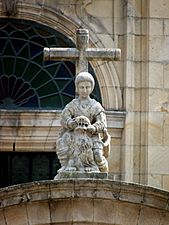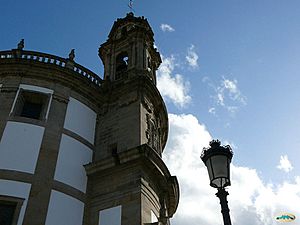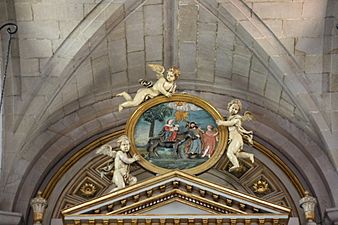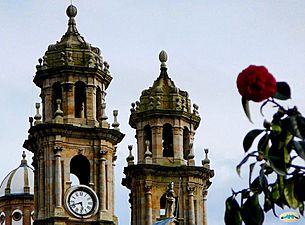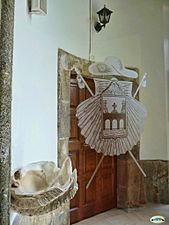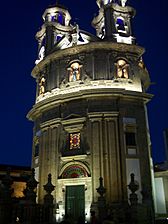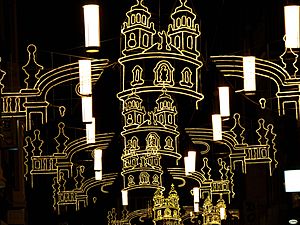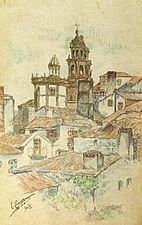Church of the Pilgrim Virgin facts for kids
Quick facts for kids Church of the Pilgrim Virgin |
|
|---|---|
|
Iglesia de la Virgen Peregrina
|
|
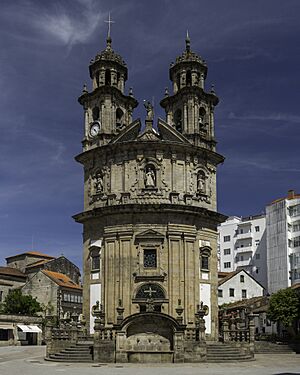
The façade of the church.
|
|
| Religion | |
| Affiliation | Roman Catholic |
| Year consecrated | 1794 |
| Location | |
| Location | Pontevedra, Galicia, Spain |
| Architecture | |
| Architectural type | Church |
| Architectural style | Baroque, Neoclassical |
| Groundbreaking | 1778 |
| Completed | 1792 |
| Direction of façade | West |
| Official name: Iglesia de la Virgen Peregrina | |
| Designated | 13 October 2011 |
The Church of the Pilgrim Virgin is a special Roman Catholic church in Pontevedra, Spain. It looks like a scallop shell! This church is found along the famous Portuguese Way of St. James, a path many pilgrims walk.
Building started in 1778. This church is one of the most famous and important buildings in Pontevedra. It's dedicated to the Virgin Mary, who people believed guided pilgrims from Bayona all the way to Santiago de Compostela.
The church holds a statue of the Pilgrim Virgin from the 1800s. She is the patron saint of the province of Pontevedra and the Portuguese Way. In 1982, it was named a historic monument. The church mixes two old styles: late Baroque and Neoclassical. Its main altar, built in 1789, shows these styles.
The church's shape is like a scallop shell, which is a key symbol for pilgrims. It ends in a Christian cross. This round shape was common in Portuguese Catholic churches back then. On October 13, 2011, it was officially named an Asset of Cultural Interest.
Contents
History of the Pilgrim Church
The idea for this church came from a statue of the Virgin Mary dressed as a pilgrim. French pilgrims brought it to Pontevedra. Many people in the city loved it, so a group was formed to worship her.
The story of the church began in 1753. A group was created to honor the Virgin of the Way. This group later became the Congregation of Our Lady of Refuge and the Divine Pilgrim.
In 1757, an altar was built for the Pilgrim Virgin statue. It was placed in an older church called the Chapel of Nuestra Señora la Virgen del Camino. But soon, problems arose between the two groups. They argued over things like collecting money and ringing bells.
Because of these issues, the city leaders ordered the Pilgrim Virgin statue and its altar to be moved. They were placed in a new wooden chapel outside the old walls of Pontevedra. This spot was near the Trabancas Gate.
Two years later, on June 18, 1778, the first stone of the new church was laid. This was paid for by the Brotherhood of Nuestra Señora del Refugio y Divina Peregrina. The plans were drawn by Antonio Souto, a master builder. The church was finished in 1792. The bells, door, and stained glass windows were put in place. The front area, called the atrium, was finished two years later. On August 2, 1794, after 16 years of work, the church was blessed. The first mass was held there.
Around 1795, a big storm damaged the church. Part of its north tower fell down. It wasn't fixed for 80 years, until 1873. At that time, two Lightning rods were also added. The area around the church also changed a lot over time. The city was rebuilt in the mid-1800s. The old atrium was replaced with a grand staircase.
Admiral Casto Méndez Núñez gave a huge Tridacna shell to the church. He brought it from the Pacific on one of his trips. This shell is now used as a holy water font at the church entrance. The clock in the north tower was put in in 1896. It came from the old Saint John of God Hospital, which was torn down. The hospital's bells were also moved to the church.
In 1981, the church had its first major repair. There were big cracks because the foundations had shifted. César Portela and José Bar Boo did this work. The second big repair happened in 2008. They fixed the Stained glass windows, walls, paint, and the tower clock.
The Cofradía de la Peregrina group manages the church. They paid for its building and still keep it open for worship today.
What the Church Looks Like
The church has a central floor plan. Its shape is inspired by a Scallop shell, a key symbol for Pilgrims. Inside this shell shape, there is a cross. The main part of the church is round. But with the entrance area, it looks like a scallop shell.
The round part of the church has four fluted Pilasters. These support arches and a cornice. Above this, there is a dome with windows and a small tower called a lantern.
Inside, the rectangular presbytery (the area around the altar) has a groin vault ceiling. The main altarpiece is in the neoclassical style. It was made in 1789. It has a triangular top with a carving of the flight into Egypt. Below this is the statue of the Pilgrim Virgin from the 1800s. She holds the Child Jesus. Both are dressed in short cloaks and carry a pilgrim's staff and a gourd.
You can also see paintings by Polanco and a copy of the Virgin of San Onofre. Don't miss the holy water font near the entrance. It's made from a giant Tridacna shell from the Pacific, brought by Méndez Núñez. The beautiful crystal chandelier inside is from the late 1800s. It weighs 250 kilos and is 2.50 meters tall.
The front of the church was designed by Antonio Souto. It has an atrium with a staircase. This area has a balustrade with pointed decorations. At the bottom of the stairs is a fountain. At the top, there is a statue of Teucer. The atrium and fountain create a very special and beautiful area.
The front of the church is curved and has two parts. The lower part has flat columns called Pilasters. The upper part has Corinthian columns. In a niche at the top, you'll find the Pilgrim Virgin statue. On each side, in other niches, are statues of Saint James the Greater and St. Roch. All three are dressed as pilgrims. The niches have scallop-shaped ceilings. At the very top, there's a broken triangle shape with a statue of Faith. On either side are two tall towers. These towers make the church look very elegant and grand. The lower part has a large round doorway. Above it are three windows.
A Symbol of Pontevedra
The Church of the Pilgrim Virgin has become a true symbol of Pontevedra. In 2011, the Royal Mint of Spain (FNMT) put it on a special coin. This coin was part of a series showing the capitals of Spain's provinces.
The coin is worth 4 Reales and is made of silver. They made 15,000 of these coins. The Royal Mint explained why they chose the church:
The Sanctuary of the Pilgrim Virgin is one of the most important buildings in Pontevedra. It was built in the 1700s. Its shape looks like a Scallop shell, which is a worldwide symbol for pilgrims going to Santiago de Compostela. It is in the middle of the city, on the route of the Portuguese Way. The Brotherhood of the Pilgrim Virgin paid for it. It has been named an Asset of Cultural Interest.
Spain's postal service, Correos, also featured the church. On December 12, 2014, they used its image on a special postmark. This postmark was used at the main post office in Pontevedra. Correos did this to help share images of famous places and monuments.
Gallery
Related articles
- Plaza de la Peregrina]
See also
 In Spanish: Iglesia de la Virgen Peregrina para niños
In Spanish: Iglesia de la Virgen Peregrina para niños







